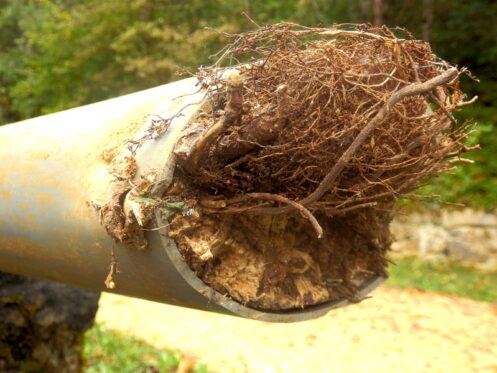If you’re a Colorado homeowner, you know how valuable a healthy landscape is—but did you know those beautiful trees in your yard might be setting the stage for one of the most common plumbing headaches around? Tree roots and sewer lines don’t mix. When tree roots find their way into your pipes, it can mean clogs, backups, sewer line damage, and plenty of stress.
The good news? With a little know-how, it’s easier than you think to stay ahead of root problems. This guide breaks down why roots grow into sewer lines, what signs to watch for, and what you can do to fix and prevent the damage—without the stress.
And if you need a hand? The team at Precision Plumbing Heating Cooling & Electrical is ready to help with expert inspections, root removal, and trenchless repairs across Colorado.
Why Do Tree Roots Target Sewer Lines?
Colorado’s climate is ideal for stunning trees, but their roots are always seeking out two things your sewer pipes offer in abundance: moisture and nutrients.
- Moisture: Even the smallest leak from a pipe joint creates enough dampness to attract roots from several yards away.
- Nutrients: Sewage is full of nutrients that roots love, making any access point—even a microscopic crack in your sewer line—irresistible.
Older homes throughout Colorado often have clay or cast-iron pipes that are especially susceptible to leaks and root invasion. And while modern PVC pipes offer greater resistance, no pipe is completely immune if conditions are right.
Once roots sense the moisture and nutrients escaping underground, they’ll grow steadily toward the source. Over time, roots can wrap around pipes and squeeze through tiny cracks, eventually infiltrating your sewer line interior and causing real trouble.
How Roots Get Into Sewer Pipes
Roots are persistent and opportunistic. Here’s how they sneak in:
Common Entry Points
- Cracks and Small Gaps: Aging, shifting soil, or freezing and thawing cycles can cause pipes to crack or joints to loosen.
- Pipe Connections: Joints between pipe sections are frequent weak spots.
- Broken Seals: Over time, even quality installations can develop gaps that provide an entryway.
Once inside, roots thrive on the water and nutrient-rich waste travelling through your pipes. With regular access, the roots will grow rapidly, expanding and multiplying, causing problems that worsen over time.
What Problems Do Roots Cause in Sewer Lines?
Roots are one of the top causes of sewer line problems for Colorado homeowners. Here’s what can happen if they aren’t removed:
Blockages and Clogs
As roots grow, they form tangled masses that catch debris, grease, and waste. This can lead to frequent, stubborn clogs, slow drains throughout your home, and, eventually, damage to your plumbing system.
Sewer Backups
When a major root mass blocks your main sewer line, wastewater has nowhere to go but back up through the lowest points of your home, such as floor drains, bathtubs, or basement plumbing. It’s a messy, unsanitary problem that can quickly lead to costly water damage.
Pipe Damage and Leaks
Roots don’t just clog pipes. They can also force pipes apart or even break them, causing widespread leaks underground. Significant damage increases repair or replacement costs and can put your home’s foundation at risk.
Structural Risks
Intense root activity can destabilize the soil around your home’s foundation. Extensive root growth under and around pipes contributes to soil erosion, putting your entire structure at risk if left unchecked.
Warning Signs of Roots in Your Sewer Lines
Most root intrusions begin subtly. Catching these warning signs early can save you a lot of trouble (and money):
- Slow draining sinks, tubs, or showers (especially if multiple fixtures are affected)
- Gurgling sounds from drains or toilets after flushing
- Foul odors coming from your drains, suggesting sewage buildup or backup
- Frequent, stubborn clogs that don’t respond well to plungers or drain cleaners
- Fluctuating toilet water levels
- Lush, greener patches of grass or soggy spots in your yard, even during dry spells
If any of these signs sound familiar, don’t wait to act! Root intrusions will not fix themselves, and their impact will only get more damaging over time.
How to Remove Tree Roots and Restore Your Sewer Line
If you suspect tree roots are causing problems in your sewer line, here’s what to expect when you call a trusted plumber like Precision Plumbing, Heating, Cooling & Electrical:
Step 1: Professional Sewer Scope
A professional plumber will use a flexible high-definition camera to inspect the inside of your main sewer line. This helps pinpoint the exact location, extent, and nature of any root intrusion.
Step 2: Cutting and Removing Roots
Depending on the severity, your plumber might use one or a combination of these methods:
- Mechanical Augers and Drain Snakes: Special attachments are used to chop and break up root masses, clearing the way for water to flow again.
- Hydro Jetting: High-pressure water jets are deployed to blast roots and debris out, thoroughly cleaning the inside of your pipes.
Step 3: Repair or Replace Damaged Sections
If the roots have caused significant damage to your pipes, you may need sectional repair or even a full sewer line replacement. Fortunately, modern plumbing companies offer trenchless repairs that reduce the need for extensive digging, protecting your landscaping and minimizing disruption to your property.
Preventing Future Tree Root Intrusions
While Colorado’s beautiful trees are worth preserving, a few proactive steps can help prevent root-related sewer problems:
Regular Sewer Inspections
Schedule a professional sewer line inspection every couple of years, especially if your home’s pipes are older or you have large trees nearby. Early detection is much less expensive than emergency repairs.
Smart Landscaping Choices
When planting new trees, opt for species known to have less aggressive roots and plant them as far away from utility lines as possible. Your local nursery or tree service can guide you on smart choices for our Colorado climate.
Preventative Root Treatments
Annual or semi-annual applications of safe root control products can keep small problems from becoming big ones.
Prompt Attention to Early Signs
Take early warning signals seriously. Addressing minor issues right away can save thousands of dollars in repairs and protect your property value.
Why Fast Action Matters
Acting quickly when you suspect a root problem isn’t just about avoiding inconvenience. Root-damaged sewer lines can collapse, leading to major backups, unsanitary conditions, and expensive property damage. Once roots make their way into your sewer line, they only become more aggressive.
Professional help is critical. DIY approaches might clear a blockage temporarily but won’t eliminate the root of the problem (pun intended!). Trust local, licensed, and highly-rated professionals who have the technology and expertise to protect your Colorado home.
Trust Precision Plumbing, Heating, Cooling & Electrical for Sewer Line Solutions
For decades, Colorado homeowners have relied on Precision Plumbing, Heating, Cooling & Electrical for their drain and sewer needs. Here’s what makes them different:
- Fast, Same-Day Service: Count on prompt, professional help when you need it most.
- Expert Camera Inspections: Modern, non-invasive diagnostics save time and money.
- Effective Root Removal: Advanced tools, hydro-jetting, and safe chemicals restore flow.
- Trenchless Sewer Repair: Wherever possible, repairs are done with minimal digging and disruption.
- Clear Up-Front Pricing: You’ll know the cost before any work begins.
- Meticulous, Licensed Technicians: Local professionals who care about your home and neighborhood.
Whether you suspect a root problem or simply want peace of mind, contact the Precision Plumbing, Heating, Cooling & Electrical team for inspection, maintenance, or emergency repairs.
Don’t wait for a backup. Protect your home, yard, and peace of mind. Contact us to schedule your sewer line inspection or repair with Precision Plumbing, Heating, Cooling & Electrical today!



